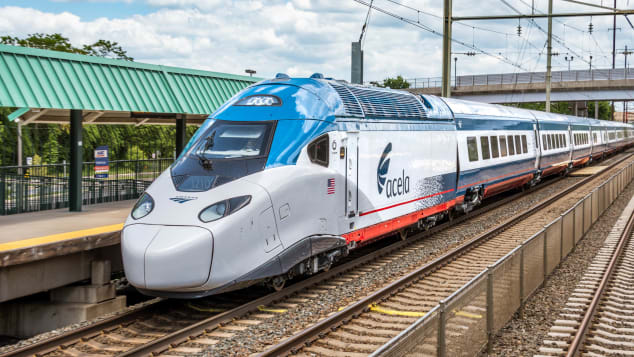By ROBB MOORE
For Ohio Capital Journal
A few years ago, I took a trip out to the Pacific Northwest, a part of the country I had never visited before. I stayed with college friends in Portland and Seattle then bunked up in a hostel in Vancouver. On my trips between the cities, I took the train.
A lot of us have romantic attraction to the train as a mode of transportation. I recall waiting at old train stations and hearing the announcements for boarding the train. I even remember riding on the train and the conductor making a wry joke, dryly deeming every town we passed through “The Jewel of the Pacific Northwest.”
Today, Ohio has a chance to substantially expand its passenger rail service. Currently, the only rail that goes through Ohio is a Lake Erie route that passes from Chicagoland into Toledo, through Cleveland, then out to Buffalo and Pittsburgh and a Cincinnati line that goes out to Indianapolis to the West and through West Virginia in the East. Columbus has no passenger rail.
Part of the federal infrastructure bill is $100 million in rail investment to build lines between Cincinnati, Dayton, Columbus, and Cincinnati. In order to get the money and the lines, though, the Ohio state government needs to agree with the feds to start splitting the operating costs with the federal government five years after the lines are in, which would cost the state about $9-10 million a year. This would be an about-face from past policy, when Governor John Kasich a decade ago turned down a deal for a high-speed rail line to connect Cincinnati, Cleveland, and Columbus.
I don’t want to diminish $10 million: you can do a lot with $10 million. But it’s worth noting that Ohio already does a lot with $10 million. The current FY 2022 budget for the state of Ohio has over 300 line items that total $10 million or more, ranging from grants for sports events to cultural facilities lease rental bond payments to the “meat processing investment program.” Overall, a $10 million operating expense would amount to one hundredth of a percentage point of the total state operating budget this year.
Another way to think about this is in the context of the massive Intel deal. The most recent reports suggest that the scope of state spending on the project puts incentives in the $2 billion range. This means that the cost of expanding Amtrak in Ohio would take over 200 years to catch up with the one-year cost of the Intel deal.
Intel purportedly will have a large impact on the state economy. But we also know that state incentives are only a fraction of the decision making criteria for a big company location like this and that somewhere from 75% to 98% of firms would decide to make location decisions without incentives at all. This stands in contrast to the clear decision the state has currently to spend $10 million a year or pass on expanded passenger rail.
I don’t know the total economic benefits of the Amtrak deal in Ohio. What I do know is that if the state is seeing its spending as a diversified investment pool for encouraging economic growth, reducing poverty and inequality, and improving lives, then expanded passenger rail seems like a prudent asset to add to its portfolio.
***
Also from Ohio Capital Journal:
Confidence wanes in legislature’s ability to pass new congressional map
The tide seems to be turning on congressional redistricting, with legislative leaders saying the process lacks needed support in the General Assembly, and will likely head back to the Ohio Redistricting Commission.
A day after legislative maps were sent back to the ORC for a third time, a co-chair of that commission says the congressional map is headed that way as well.
House Speaker Bob Cupp told media at the Statehouse on Tuesday that a two-thirds vote would not be possible in the legislature, which is necessary to be able to pass a congressional map in the General Assembly.
Because of that lack of support, a redistricting plan could not include an emergency clause, which would be needed for the plan to take effect immediately. The legislature was on the clock to pass a revised plan by Feb. 13 (Super Bowl Sunday), and for that plan to become effective in time for the May primary.
Bills typically take effect 90 days after the governor’s signature, which would conflict with the primary deadlines.
A spokesperson for Senate President Matt Huffman said because a commission vote doesn’t need an emergency clause, “it makes sense for the congressional map to go to the commission” if a two-thirds vote isn’t possible. READ MORE
Concealed carry expansion bill nears final vote; other gun bills advance
The state House is teeing up a final passage vote on legislation to remove training and background check requirements to carry a concealed firearm in Ohio.
Meanwhile, lawmakers inched forward on a bill to relax penalties for people carrying concealed weapons in prohibited places, and another restricting how local police can limit firearms sales or transportations during a “riot.”
On Tuesday, the House Government Oversight Committee reviewed Senate Bill 215, which would allow anyone 21 and up to carry without a permit so long as they lawfully possess the gun in question. Current law requires Ohioans to undergo eight hours of training and a background check to obtain a CCW permit.
Republicans in the House passed a near identical bill last year, rendering passage more likely than not. The committee passed it in an 8-5 party line vote. The full House passed it in a 60-32 party line vote. It’s up for another hearing Wednesday.
Should the House pass the legislation again (they passed the same language contained in a different bill last year), it would go to the desk of GOP Gov. Mike DeWine. The governor has declined to take a position on the bill in public statements but told the Buckeye Firearms Association in writing during the 2018 primary that he would support a constitutional carry bill. READ MORE
Once claiming moderation, Ohio secretary of state says Trump has a point about voter fraud
When he was running for office in 2018, Ohio Secretary of State Frank LaRose said overblown election claims by Democrats and Republicans hurt Americans’ faith in democracy. Democrats overhype what they call voter suppression and Republicans overblow claims of voter fraud, LaRose said at the time.
Now that he’s running for reelection, LaRose, a Republican, is singing a different tune. He went so far last week as to claim that former President Trump — who has relentlessly lied about voter fraud and tried to overturn the 2020 presidential election — has a point.
LaRose took to Twitter to accuse the media of unfairly downplaying the threat of voter fraud.
“Here they go again,” LaRose tweeted. “Mainstream media trying to minimize voter fraud to suit their narrative.”
LaRose followed that with a series of tweets in which he played up referrals of possible voting crimes that his office made to Attorney General Dave Yost. Then LaRose wrote this about voter fraud elsewhere: “It’s an even bigger problem in other states where laws & leaders are weak. President Trump is right to say voter fraud is a serious problem. More to come.”
That’s a far cry from what LaRose was saying on the campaign trail in 2018.
Nobody “should overstate the existence of either fraud or suppression because I think what it does is undermines the confidence that voters have,” WKSU quoted him as saying at the time. READ MORE





